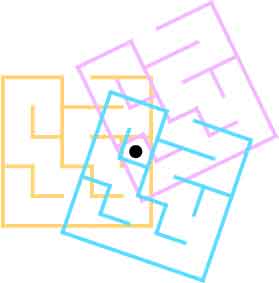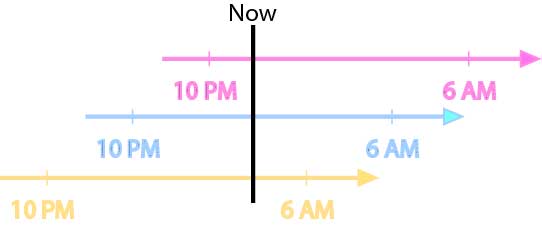This post attempts to give a more intuitive explanation of my perspective-based solution to anthropic paradoxes. By using examples, I want to show how perspectives are axiomatic in reasoning.
For each of us, our perceptions and experience originate from a particular perspective. Yet when reasoning we often remove ourselves as the first-person and present our logic in an objective manner. There are many names for this way of thinking, e.g. “take the third-person view”, “use an outsider’s perspective”, “think as an impartial observer”, “the god’s eye view”, “the view from nowhere”, etc.
I think the best way to highlight the differences between god’s-eye-view reasoning and first-person reasoning is to use examples. Imagine during Alex’s sleep some mad scientist placed him in a maze. After waking up, he sees the scientist left a map of the maze next to him. Nonetheless, he is still lost. Here we can say, given the map, the maze is known. Alex is lost because he doesn’t know his location.

Figure 1. From a god’s eye view, the maze’s location is known. But Alex’s location is unknown. The colored dots show some possibilities given Alex’s immediate surroundings.
In contrast, an alternative interpretation is to think in Alex’s shoes. I can say of course I know where I am. Right here. I can look down and see the place I am standing on. No location in the world is more clearly presented to me than here. I’m lost because I don’t know how is the maze located relative to me, even with the map.

Figure 2. Here is known. The maze’s location is unknown. The colored parts show some possibilities.
This difference also exists in examples involving time. Imagine a thunder wakes Alex up at night. Here we can say he doesn’t know what time it is. Maybe he went to bed at 10 pm and his alarm clock rings at 6 am. There is no information to place his awakening on the time axis.

Figure 3. From a god’s eye view, it is known when Alex went to bed and when the alarm clock is going to ring. But the time when the thunder wakes him up is not known. Colored lines show some possibilities.
Alternatively, we can think from Alex’s perspective as he wakes up. I can say of course I know what time it is. It is now. It is the time most immediate to my perception and experience. No other moment is more clearly felt. What I don’t know is how long ago was 10 pm when I went to bed, and how far in the future will my alarm clock ring at 6 am, i.e. how other moments locate relative to now.

Figure 4. Now is known. But how other moments locate relative to now is unknown. The colored part shows some possibilities.
The same difference also exists when identities are involved. Imagine Alex and Adam are identical twins. They got into a fatal accident while traveling in the same vehicle. One of them died while the other suffers complete memory loss. If they look the same and have the same belongings, it can be said there is no way to tell who survived the tragedy.

Figure 5. The past is known. The survivor is unknown. The colored parts show two possible outcomes.
There are other ways to describe the situation. For example, if we take the perspective of the survivor, it is obvious who survived the accident. I did. This self-identification is based on immediacy to the only subjective experience available: all senses felt are due to this body. No other persons or things are more closely perceived. Whether I was Alex or Adam, however, is unknown. In a sense, I don’t know how was the world located relative to me.

Figure 6. Obviously, I survived the accident while the other twin didn’t. However, the past is unknown. Whether I was Adam or Alex is lost. Colored parts show the two possibilities.
These examples show how different perspectives analyze problems differently. Without getting into all the details I want to stress the following points:
- First-person thinking is self-centered. Special consideration is given to here, now, and I. The perspective center is regarded as primitively understood due to its closeness to perception and subjective experience. It is the reasoning starting point. Other locations, moments, and identities are defined by their relative relations to the perspective center.
- First-person and god’s-eye-view are two distinct ways of reasoning. They should not be used together. For example, in the maze problem, we cannot say both the maze’s and Alex’s locations are known. While the former is true from a god’s-eye-view and the latter is true from Alex’s first-person perspective, mixing the two would make the whole “lost in the maze” situation unexplainable.
Anthropic problems are unique because they are formulated from specific first-person perspectives (or a set of perspectives). There is no straightforward god’s-eye-view alternative.
Take the sleeping beauty problem as an example. It asks for the probability when beauty wakes up in the experiment. However, there may be two awakenings. From a god’s eye view, the problem is not fully specified. Which awakening is being referred to? Why update the probability base on that particular awakening? But things are clear from beauty’s first-person perspective. I should obviously update my belief base on my experience: base on this awakening right now, the one I have experience of. From beauty’s point of view, today is primitively understood, no clarification is needed to differentiate it from the other day. And we intuitively recognize the problem is asking about a specific awakening/day.
Paradoxes ensue when we try to answer the problem from a god’s eye view while keeping that intuition. As pointed above, the awakening is not specified from god’s eye view. We mistakenly try to fill in the blanks with additional assumptions. For example, regard this awakening as randomly selected from all awakenings (Self-Sampling Assumption), or regard today as randomly selected from all days (Self-Indication Assumption). By redefining the first-person center from the god’s eye view, these assumptions provide the seemingly missing part of the question: which specific awakening is being referred to, and why update the probability base on that particular awakening.
Different anthropic assumptions give different answers, which also leads to different paradoxes. However, these assumptions are redundant because the question should have been answered the same way it is asked: from Beauty’s first-person perspective. There is no reference class for I, here, and now. They are primitively identified right from the start, not selected from some similar group. Even the superficially innocent notion of “I am a typical observer” or “now is a typical moment” is false. From a first-person perspective, I, now, and here are inherently special as shown by the self-centeredness.
The correct answer is simple. From Beauty’s viewpoint, there is no new information as I wake up in the experiment. Because finding myself awake here and now is logically true from the first-person perspective. The probability stays at 1/2. From a god’s eye view, all that can be said here is there’s (at least) one awakening in the experiment.
Some argue there is new information. That being awake on a specific day is evidence suggesting there are more awakenings. Halfers typically disagree by saying it is unknown which day it is. Thirders counter that by saying Beauty knows it is today. Halfers often argue today is not an “objective” identification. Thirders response by saying all the details Beauty sees after waking up can be used to identify the particular day. For example, the experimenter can randomly choose one day and paint the room red and paint the room blue on the other day. If Beauty sees red after waking up, then we know Beauty is awake on the Red day. Which is unknown before. Some argue this new information favors more awakenings.
To that, I would ask: out of the two days, why update the probability base on what happens on the Red day? Why not focus on what happens on the Blue day and update the probability instead? Thirders may find this question painfully trivial: because what happens on the Blue day is not available. Beauty is experiencing the Red day. That’s reasonable. However, that means it doesn’t matter if we use the word today or use details observed after waking up, that particular day is still specified from Beauty’s first-person perspective. Yet from a first-person perspective finding myself awake here and now is expected. The argument for new information switches to a god’s eye view. As if an outsider randomly selects the Red day then finds Beauty awake. This argument depends on first-person reasoning -to specify the day, and god’s-eye-view reasoning -to calculate the prior probability of finding Beauty awake on said day. It mixes parts from two perspectives. (For a more detailed analysis see my argument against Full Non-Indexical Conditioning and perspective disagreements)
As Beauty wakes up in the experiment, some may ask “what is the probability that today is Monday?”. The answer is interesting: there is no such probability. Remember as the first-person, the perspective center is the reasoning starting point. This includes I, here, now, and by extension today. Like axioms, they cannot be explained by logic or underlying mechanics. They are identified by intuition- by their apparent closeness to subjective experience. So there is no logical way to formulate a probability about what the perspective center is.
One has to mix first-person and god’s-eye-view to validate this probability. For example, we can do so by accepting any one of the anthropic assumptions. They redefine today/this awakening as a randomly selected sample from some proposed reference class. Doing so means we can reason from a god’s-eye-view and justifies the principle of indifference to all days/awakenings. However, as discussed before, this mix is false. Now is a first-person concept that is inherently unique from all other moments. A principle of indifference categorically contradicts the self-centeredness of the first-person view. (For a more detailed discussion against self-locating probability, and why they are invalid from the frequentist or decision-making approach see my argument here).
There are quite a few points here I disagree with. Allow me to explain.
As I said in the previous reply, a mathematical statement by itself doesn't have a probability of being right/wrong. It is the process under which someone makes or evaluates said statement that can have a probability attached to it. Maybe the experimenter picked a random number from 1 to 10000 and then check that digit of pi to determine whether to destroy or wake the copy in question. And he picked ten in this case. This process/circumstance enables us to assign a probability to it. Whereas in self-locating probabilities there is no process explaining where the "I" comes from.
Also just because macrophysical objects do not exhibit quantum phenomena such as randomness does not mean the macro world is deterministic. So I would not say Lewisian halfer predicting a fair coin yet to be tossed has the probability of Heads of 2/3 is metaphysically problem-free. Furthermore, even if you bite the bullet here, there are problems of probability pumping and retro-causations. I will attach the thought experiment later.
Before going further, I wish to give PBR's answers to the thought experiment you raised. The probability that I am the clone or original is invalid. As it is a self-locating probability. The probability that today is Monday is 2/3. It is valid because both the clone and the original have the same value. There is no need to explain "which person I am". The probability that the chosen digit of pi falls between 6-0 is 2/3. It is valid for the same reason. And the probability that the coin landed heads given "I" am awake is invalid. i.e. we cannot update based on the information "I" am awake. As the value depends on if "I" am the clone or the original.
I don't think thirders would have any trouble giving a probability of 2/3 to the tenth digit of pi. All they have to do is treat "I" as a random sample between the original and clone and then conduct the analysis from a god's eye perspective: randomly select a subject among the two, then find out she is awakened in the experiment, meaning the chosen digit is twice likely to be 6-0 (2/3). If the chosen subject does not wake up in the experiment then the chosen digit must be 1-5 (100%). They can also have a frequentist model as such no problem.
The thirders think reasoning objectively from a god's eye view is the only correct way. I think reasoning from any perspective, like that of an experiment subject's first-person perspective, is just as valid. And from the subject's first-person perspective the original sleeping beauty problem has a probability of 1/2, verifiable with a frequentist model. I thought you agreed with this.
However, if you endorse traditional Lewsian halfer's reasoning or SSA, which seems clear to me given your latest thought experiment with cloning and waking, then you can't agree with me on that. Furthermore cannot use the subject's first-person perspective, or the subsequent perspective disagreement, as a supporting argument for halving.
Consider this experiment. You will be cloned tonight in your sleep with memories preserved. Then a coin would be tossed, if Heads a randomly selected copy would be waked up in the morning. The other one would sleep through the experiment. If Tails both would be waked up. So after waking up the next day, what is the probability of Heads?
Thirders would consider this problem logically identical to the original sleeping beauty. I would guess as a Lewsian Halfer, you would too, and still giving the probability as 1/2. But for PBR, this problem is different. The probability of Head would rightfully be 1/3 in this case. As "I am awake in this experiment" is no longer guaranteed, it gives legitimate new information. And if I take part in such experiments repeatedly and count on my personal experience, the relative fraction of Heads in experiments where I got waken up would approach 1/3. So here you have to make a choice. If you stick with Lewsian Halfer's reasoning, then you have to give up on thinking from a subject's first-person perspective. Therefore cannot use it as a supporting argument for halving, nor use it as an explanation for the peculiar perspective disagreement. If you still think thinking from a subject's first-person perspective is valid, then you have to give up on Lewisian reasoning, and cannot update the probability of Head to 2/3 after learning you are the chosen one who will be wakened up anyway. To me that is a really easy choice.
If you think predicting Heads with a probability of 2/3 is correct, there are other issues. For example, you can get a bunch of memory-erasing drugs, then you will have the supernatural predicting power. Before seeing the toss result, you can form the following intentions: if it comes up in tails I would take the drugs N times. To have N near-identical awakenings and revealings. Then by Lewsian Halfer (or SSA), if Heads then I would have been experiencing this revealing for sure. If Tails the probability of me currently experiencing this particular awakening would be 1/N. Therefore the probability of Heads is 1/(N+1). And you can squeeze that number as little or large as you want. All you have to do is to take the appropriate number of drugs after a certain result is revealed. By doing so you can retroactively control the coin toss result.